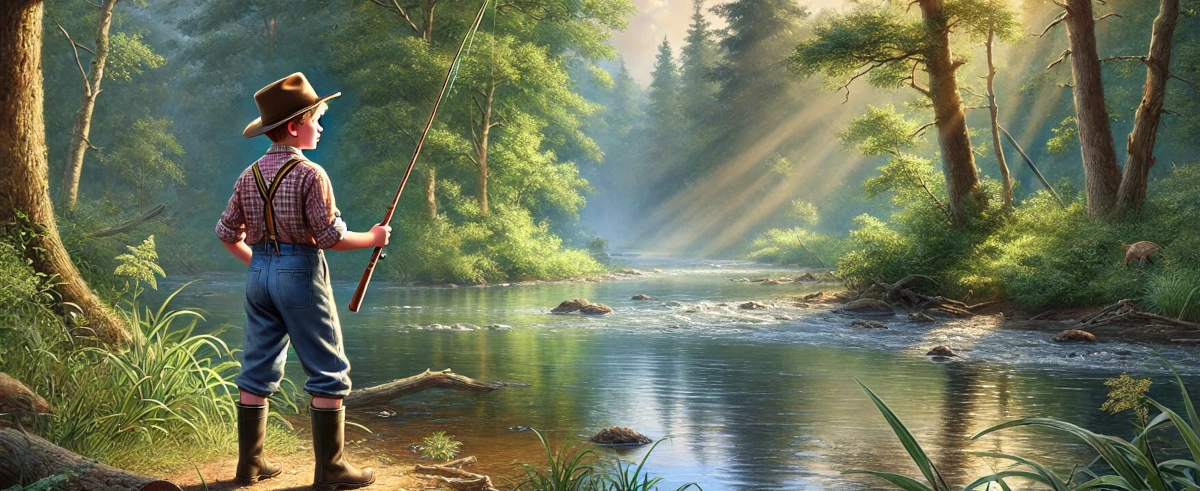Step back in time to the quaint town of St. Petersburg, Missouri, and meet Tom Sawyer, a mischievous boy with a thirst for adventure. Mark Twain’s “The Adventures of Tom Sawyer” spins a timeless tale of childhood freedom, brimming with playful schemes, daring escapades, and the kind of imaginative spirit that captures the essence of youth. This beloved classic appeals to both young readers discovering the joy of adventure stories and adults who want to revisit the magic of childhood. Through Tom’s escapades, readers of all ages can experience the universal themes of friendship, first love, and the challenging transition from childhood innocence to growing maturity.
Key Concepts
Childhood Freedom and Imagination
Tom Sawyer’s world is a canvas of endless possibilities. Everyday life transforms into a grand adventure, whether he’s playing pirates along the Mississippi River or embarking on thrilling treasure hunts. In the famous fence-whitewashing scene, Tom cleverly convinces his friends that painting the fence is a privilege rather than a chore. He trades small treasures like marbles and bits of glass for the “opportunity” to work, accumulating a wealth of boyhood riches while getting his chore done. This ingenious manipulation demonstrates both Tom’s wit and Twain’s insight into human nature. When Tom, Huck, and Joe Harper run away to Jackson’s Island, they live out their pirate fantasies for three days, hunting, fishing, and swimming freely. Their adventure shows how children create their own worlds through play, though their eventual return home reveals the limits of such escape.

Morality and Social Hypocrisy
The adult world of St. Petersburg often presents a stark contrast to Tom’s carefree existence. When the town’s model citizen, Dr. Robinson, is murdered, the community quickly blames Muff Potter, a harmless drunk, while the true killer, Injun Joe, maintains his respectable facade. Tom and Huck witness the murder in the graveyard but initially stay silent out of fear, struggling with their consciences until Tom finally testifies at Potter’s trial. This moral crisis forces Tom to confront adult responsibilities and shows how appearances can deceive in the supposedly upright world of grown-ups. The townspeople’s treatment of both Potter and Injun Joe reflects the prejudices and social hierarchies of the time, which Twain skillfully exposes through his narrative.
Love and Romance
Tom’s infatuation with Becky Thatcher brings both comedy and emotional depth to the story. Their courtship follows the rituals of childhood romance: Tom shows off by walking on his hands, they share an awkward “engagement” sealed with a kiss, and their relationship suffers its first break when Tom accidentally reveals his previous “engagement” to Amy Lawrence. When Becky tears the schoolmaster’s prized anatomy book, Tom takes the blame and endures a severe whipping to protect her, showing how his feelings have matured from simple showing off to genuine sacrifice.
Adventure and Danger
The story’s playful tone shifts dramatically when Tom and Becky become lost in McDougal’s Cave. For three days, they wander in complete darkness, their candles burning out one by one. Tom’s resourcefulness emerges as he carefully marks their path with kite string and continues searching for an exit even as their food and light run out. This life-or-death situation transforms Tom from a mischievous boy into a protective hero. The discovery of Injun Joe’s body in the cave, after he was accidentally trapped inside, provides a grim reminder of the real consequences that can accompany adventure.
Conclusion
“The Adventures of Tom Sawyer” transcends the boundaries of a simple children’s book. Through masterful storytelling and satirical wit, Twain creates a work that entertains while offering sharp insights into human nature, social conventions, and the bittersweet transition from childhood to maturity. The book’s enduring relevance lies in its ability to capture universal experiences and emotions while providing a vivid portrait of life along the Mississippi River in the mid-nineteenth century.
Did you find this content helpful?
While we strive to provide comprehensive summaries, they cannot capture every nuance and insight from the full book. For the complete experience and to support the author's work, we encourage you to read the full book.
Note: You'll be redirected to Standard Ebooks, which offers free, high-quality, open source ebooks from the public domain.
Recommended Books
If you enjoyed “The Adventures of Tom Sawyer,” these books might also capture your interest:
“Adventures of Huckleberry Finn” by Mark Twain: This companion novel follows Tom’s friend Huck on a more serious adventure down the Mississippi River, expanding on themes of freedom and social criticism while offering a darker perspective on American society.
“Little Women” by Louisa May Alcott: This beloved coming-of-age story set in Civil War-era America explores themes of childhood, family bonds, and growing up that parallel Tom’s journey, though from a different perspective.
“The Prince and the Pauper” by Mark Twain: Another of Twain’s classics that, like Tom Sawyer, uses young protagonists to explore themes of identity, social class, and adventure in a way that appeals to both children and adults.
Here are two books on different topics that might appeal to readers who enjoy coming-of-age adventures:
“Treasure Island” by Robert Louis Stevenson: This classic tale of pirates and buried treasure offers the same mix of adventure and moral challenges that readers enjoy in Tom Sawyer, though in a different setting.
“The Adventures of Sherlock Holmes” by Arthur Conan Doyle: These detective stories feature the same elements of mystery and clever problem-solving that Tom displays, appealing to readers who enjoy following clues and unraveling puzzles.